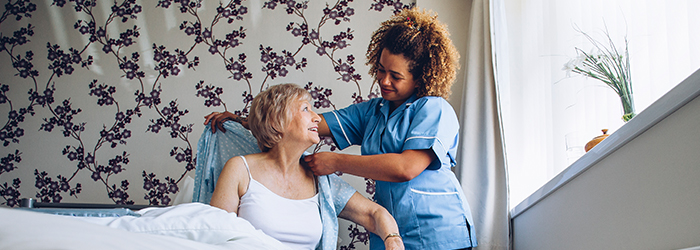Hospice Keeps Your Patients Safe at Home

Can your seriously ill patients live and die at home? Yes — and studies show that the care they receive is more appropriate, far less costly and meets their preferences near the end of life.
That is due in large part to the expertise a hospice provider brings to end-of-life comfort care: addressing pain and other symptoms while attending to spiritual and psychosocial issues.
Hospice Educates Family Caregivers
Along with supporting the patient and family with professional care, hospice must also educate family caregivers, who provide the bulk of the patient’s care.
Good communication is key. The team and family must agree on the goals of care so that everyone is on task.
The team is in the home and can see the layout, the areas the patient tends to use, what tasks fall to one or many family caregivers. The team is monitoring for anything that might result in harm to the patient.
Homes are often not designed to provide healthcare, and caregivers may vary in number and ability. Everyone needs to communicate questions and concerns, from slip-and-fall hazards to moving the patient safely. Then, when a family visitor or would-be caregiver offers to lend a hand, the paradigm is in place and there is less chance of a mistake or misunderstanding that can lead to injury.
VITAS Healthcare serves to keep your seriously ill patients safe and allows them to live and die at home.
Here's What Hospice Teaches Families about Infection Control
When working with families and caregivers, one area we discuss is infectious disease. Here are some of the infection control measures we ask caregivers to follow:
1. Maintain good personal hygiene.
- Wash your body frequently.
- Wash your hair at least twice a week.
- Brush your teeth and rinse your mouth after every meal.
- Trim your fingernails and toenails weekly.
- Wear clean and laundered clothes.
- Change dirty clothing and bed linens when you notice any soiling.
2. Wash your hands frequently and thoroughly.
- Before food preparation, eating or serving food
- After using the toilet, contact with your own or another’s body fluids and blowing or wiping your nose.
Best hand-washing procedure:
- Wet your hands with plenty of soap and warm water.
- Work up lather over your hands and wrists.
- Rub the palm of one hand over the back of the other and rub them together several times, then repeat with other hand.
- Interlace the fingers of both hands and rub them back and forth.
- Clean under your fingernails with a nailbrush or orange stick.
- Rinse your hands thoroughly under warm running water.
- Dry your hands and wrists thoroughly.
3. Clean your household thoroughly.
- Avoid household clutter.
- Thoroughly ventilate your home with disinfecting fresh air.
- Clean the kitchen counter with a scouring powder.
- Dust and vacuum weekly.
- Mop the kitchen and bathroom floors weekly and when spills occur.
- Clean inside the refrigerator weekly with soap and water.
- Add a teaspoon of bleach to each quart of water used for flower vases.
- Wear gloves when cleaning birdcages, litter boxes, aquariums, etc.
4. Clean contaminated household and medical equipment thoroughly.
- Clean medical equipment as directed by your VITAS Home Medical Equipment representative.
- Clean soap dishes, denture cups, etc., weekly.
- Do not use the same sponge to clean bathroom and kitchen.
- Do not pour mop water down the kitchen sink.
- Do not clean sponges or rags at the kitchen sink.
- Disinfect mops and sponges weekly by soaking in one part bleach to nine parts water for 5 minutes.
5. Decrease your exposure to people with infectious diseases.
- Avoid crowds whenever possible.
- Avoid people who have been recently vaccinated.
- Do not share food or drink with others.

Check Hospice Guidelines
Get diagnosis-specific guidelines in our hospice eligibility reference guide.
Hospice Guidelines by Diagnosis Refer Your Patient